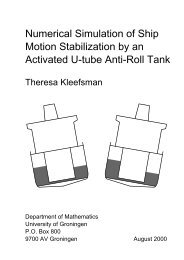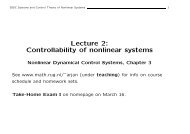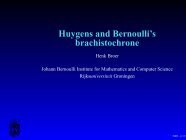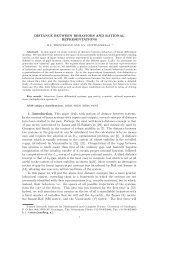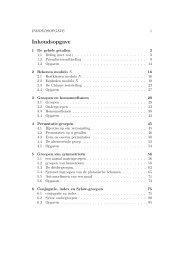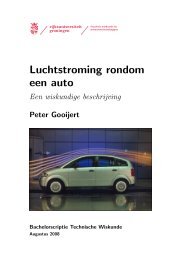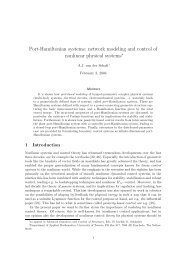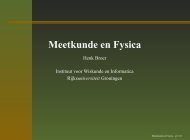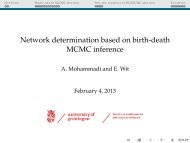Cubic Surfaces Jaap Top - Wiskunde
Cubic Surfaces Jaap Top - Wiskunde
Cubic Surfaces Jaap Top - Wiskunde
Create successful ePaper yourself
Turn your PDF publications into a flip-book with our unique Google optimized e-Paper software.
<strong>Cubic</strong> <strong>Surfaces</strong><br />
<strong>Jaap</strong> <strong>Top</strong><br />
IWI-RuG & DIAMANT<br />
8 October 2009<br />
(Utrecht maths colloquium)<br />
1
starting point: Marcel van der Vlugt (Leiden),<br />
“An application of elementary algebraic geometry<br />
in coding theory ”,<br />
Nieuw Archief voor <strong>Wiskunde</strong> (4th series, vol. 14, 1996)<br />
same result using elliptic curves by G. van der Geer and M. van<br />
der Vlugt (1994) and elementary proof by coding theorists<br />
G. L. Feng, K. K. Tzeng, and V. K. Wei (1992)<br />
2
Problem: fix m ≥ 1, put n := 2 m − 1 and enumerate<br />
F 2 m = {0, α 1 , α 2 , . . . , α n } .<br />
The binary code<br />
BCH(m) := { (a 1 , a 2 , . . . , a n ) ∈ F n 2 ; ∑ a i α i = 0 = ∑ a i α 3 i<br />
}<br />
.<br />
Alternative: put F 2 m = {0} ∪ {α l ; l ∈ Z}.<br />
Then<br />
BCH(m) = { f = ∑ a i x i ∈ F 2 [x]/(x n − 1) ; f(α) = 0 = f(α 3 ) } .<br />
3
Easy: every v ≠ 0 in BCH(m) has at least 5 coordinates 1.<br />
How many v have precisely 5 coordinates 1<br />
Idea: if x 1 , x 2 , x 3 , x 4 , x 5 ∈ F 2 m are the powers of α which give v,<br />
then<br />
{<br />
x1 + x 2 + x 3 + x 4 + x 5 = 0<br />
x 3 1 + x3 2 + x3 3 + x3 4 + x3 5 = 0.<br />
So the problem boils down to: count the points with coordinates<br />
in F 2 m on the projective surface S defined here.<br />
4
S defines a (smooth) cubic surface.<br />
It was first studied by Alfred Clebsch:<br />
Mathematische Annalen Vol. 4 (1871), see page 331.<br />
Let P := (1 : ζ 1 : ζ 2 : ζ 3 : ζ 4 ) ∈ S and ¯P := (1 : ζ 4 1 : ζ4 2 : ζ4 3 : ζ4 4 ) ∈<br />
S, in which the ζ j are the four different primitive 5th roots of<br />
unity (in F 16 ).<br />
The line containing P and ¯P is contained in S. Permuting the<br />
primitive roots of 1 gives 12 such lines in S (in fact, two sets of<br />
6 pairwise disjoint lines).<br />
5
There are more straight lines contained in S: any system x i +x j =<br />
0 = x k + x l with 1 ≤ i, j, k, l ≤ 5 pairwise different, also yields a<br />
line in S. In total, this yields another 15 lines.<br />
Using 4 of the rational lines and a pair of conjugate ones, it is<br />
possible to obtain a set of 6 pairwise disjoint lines (which as a<br />
set is defined over F 2 ).<br />
One now contracts this set of 6 lines to 6 points. This can be<br />
done over F 2 . The image of S under this turns out to be (over<br />
F 2 ) isomorphic to the projective plane.<br />
Since counting on the projective plane is trivial, this allows one to<br />
count on S as well, and hence to determine the desired number<br />
of vectors v in BCH(m).<br />
6
Alfred Clebsch (1833–1872)<br />
7
student Adolf Weiler (Göttingen) instructed by Clebsch made a<br />
plaster model of the real surface given by the same equations.<br />
More precisely: take (x, y, z) such that<br />
yields in x, y, z coordinates:<br />
− √ 6x + y + √ 2z = 3x 1 + 3<br />
√<br />
6x + y +<br />
√<br />
2z = 3x2 + 3<br />
y − √ 8z = 3 + x 3<br />
y = x 4 − 3<br />
− 2y = x 5<br />
8
Clebsch’s diagonal surface<br />
9
1872, Sitzungsbericht der Königlichen Gesellschaft der Wissenschaften<br />
zu Göttingen, August 3:<br />
10
Same journal, 1872, August 3:<br />
A reproduction is since 2009 used for the Compositio Prize<br />
11
Also 1872, 3 months later,<br />
Abhandlungen der Königlichen Gesellschaft der Wissenschaften<br />
in Göttingen:<br />
12
Reproductions of plaster and string and wire models were made<br />
and sold (and advertized) by L. Brill in Halle (brother of Alexander)<br />
and later by M. Schilling in Leipzig.<br />
The mathematics departments in Amsterdam, Leiden, Utrecht<br />
and Groningen still own many such models.<br />
In Groningen this is due to P.H. Schoute (1842 - 1910)<br />
13
Pieter Hendrik Schoute (1842–1910)<br />
15
July 1890, American Journal of Mathematics<br />
16
Question: is one of the original Clebsch diagonal surface plaster<br />
reproductions still present in a Dutch institute<br />
(a modern one, Groningen)<br />
18
Duco van Straten and Stephan Endraß had many copies made<br />
using a 3D printer in Mainz<br />
19
Heinrich Heine Universität, Düsseldorf<br />
(1999, Claudia Weber & Ulrich Forster, ceramics)<br />
20
Special property of Clebsch’s diagonal surface S: each of the<br />
planes x j + x k = 0 intersects S in a union of three concurrent<br />
lines.<br />
Point of intersection of three such lines is called Eckardt point.<br />
The Clebsch surface is the unique cubic with 10 such points.<br />
The Fermat cubic x 3 + y 3 + z 3 + w 3 = 0 is the unique one with<br />
18 such points.<br />
All other cubic surfaces have 0, 1, 2, 3, 4, 6 or 9 such points, as<br />
Beniamino Segre proved in 1942.<br />
F.E. Eckardt: highschool teacher in Chemnitz. He has exactly<br />
one paper, published after he died: Mathematische Annalen<br />
Vol. 10 (1876)<br />
In Utrecht, Tu Nguyen finished his PhD thesis in 2000 concerning<br />
Eckardt points.<br />
21
Math. Annalen 10 (1876) p. 227<br />
22
The starting point<br />
1849, Arthur Cayley & George Salmon<br />
Theorem. a (smooth, projective) cubic surface over C contains<br />
precisely 27 lines<br />
23
1866, Alfred Clebsch<br />
Theorem. any smooth cubic surface over C is the closure of<br />
ϕ(P 2 (C) − {p 1 , . . . , p 6 }) for certain p 1 , . . . , p 6 ∈ P 2 ,<br />
with ϕ(p) = (f 1 (p) : f 2 (p) : f 3 (p) : f 4 (p)) bijective, and<br />
∑<br />
Cfj = {f ∈ C[x, y, z] homog. of degree 3 & f(p n ) = 0, n = 1, . . . , 6} .<br />
24
example: Clebsch diagonal surface<br />
x 1 = (b − c)(ab + ac − c 2 )<br />
x 2 = ac 2 + bc 2 − a 3 − c 3<br />
x 3 = a(c 2 − ac − b 2 )<br />
x 4 = c(a 2 − ac + bc − b 2 )<br />
x 5 = −v − w − x − y.<br />
25
modern proof: choose skew lines l, m ⊂ S<br />
consider S → l × m: P ↦→ (Q, R) where P, Q, R are collinear<br />
there are five lines in S meeting l as well as m, they have a point<br />
as image (but: every line in S meets at least one of the given<br />
five; so adapt:)<br />
select one of these five image points (Q, R), ‘blow up’ l × m in<br />
(Q, R) and ‘blow down’ the lines Q × m and l × R. result: P 2 ,<br />
and inverse is P 2 → S given by cubic polynomials.<br />
(with Irene Polo, CAGD vol. 26 (2009))<br />
26
Theorem: this is possible over R if and only if the real surface<br />
given by the cubic equation is connected.<br />
x 3 + y 3 + z 3 + x 2 y + x 2 z + xy 2 + y 2 z − 6z 2 + 11z − 6 = 0<br />
27
Following Silhol & Kollár, all non-connected cubics are obtained<br />
as follows:<br />
28
Take two conics f = 0 and g = 0 intersecting in 1, 2, 3, 4.<br />
Take 5 on f = 0 and 6 on the tangent line to f = 0 at 5.<br />
If no three of 1, 2, . . . 6 are on a line, let S 0 be the cubic surface<br />
corresponding to these points.<br />
Define a rational involution τ on P 2 by the rule:<br />
{P, τ(P )} are the intersection points of the line through P and<br />
6, with the conic through P and 1, 2, 3, 4.<br />
Then S := S 0 ⊗ C/(τ ⊗ c) (with c = complex conjugation) defines<br />
a cubic surface over R having two real connected components.<br />
(with Irene Polo, Canad. Math. Bull. vol. 51 (2008))<br />
29
What about cubic surfaces over Q (or, over number fields)<br />
Thm. (Swinnerton-Dyer, 1970). A smooth cubic surface over<br />
Q is over Q birational to P 2 , if and only if it contains a rational<br />
point, and it contains a Galois-stable set of 2 or 3 or 6 pairwise<br />
skew straight lines.<br />
( Michigan Math. Journal vol. 7, 1970 )<br />
30
N.B.: in the case of a Galois-stable set of two skew lines, there<br />
is automatically a rational point: fix any rational point P in P 3 .<br />
Then P 2 can be identified with the planes in P 3 containing P .<br />
Any such plane meets each of the two skew lines in a point, and<br />
the two points obtained this way determine a line. The third<br />
point of intersection of this line with the cubic surface is rational<br />
in case the plane we started with is rational.<br />
In fact, this argument constructs a birational map from P 2 to<br />
the cubic surface.<br />
31
In the case of a Galois-stable set of 6 pairwise skew lines, the map<br />
contracting (“blowing down”) these 6 lines is birational and since<br />
the image has a rational point, it is actually isomorphic (over Q)<br />
to P 2 .<br />
So in this case we are in the situation of Clebsch’s theorem; in<br />
particular, the surface can be parametrized using polynomials of<br />
degree 3.<br />
An example: x 3 + y 3 + z 3 + w 3 = 0. Here a Galois-stable set of<br />
6 pairwise skew lines exists. So a parametrization over Q using<br />
degree 3 polynomials exists.<br />
In this case Leonhard Euler (1707 - 1783) found a parametrization,<br />
however, it uses polynomials of degree 4 . . .<br />
32
So it is possible to improve Euler’s result!<br />
parametrizations using cubic polynomials were recently found algebraically<br />
by Noam Elkies and geometrically (using the modern<br />
proof of Clebsch’s theorem above) by Irene Polo and me:<br />
x = −a 3 − 2a 2 c + 3a 2 b + 12abc − 3ab 2 − 4ac 2 + 6b 2 c + 12bc 2 + 9b 3<br />
y = a 3 + 2a 2 c + 3a 2 b + 12abc + 3ab 2 + 4ac 2 − 6b 2 c + 12bc 2 + 9b 3<br />
z = −8c 3 − 8ac 2 − 9b 3 − a 3 − 3a 2 b − 3ab 2 − 4a 2 c − 12b 2 c<br />
w = 8c 3 + 8ac 2 − 9b 3 + a 3 − 3a 2 b + 3ab 2 + 4a 2 c + 12b 2 c.<br />
33
Interest in cubic surfaces increased enormously because of applications<br />
in Computer Aided Geometric Design. Idea: use patches<br />
of cubic surfaces to approximate a surface in 3-space. Store the<br />
equation, and for displaying the surface, calculate a parametrization.<br />
Fast calculation of parametrizations (and of equations), and low<br />
degrees in the polynomials giving the parametrization, means<br />
improved efficiency.<br />
Recent work of C.L. Bajaj, T.G. Berry, R.L. Holt, L. Gonzalez-<br />
Vega, S. Lodha, A.N. Netravali, M. Paluszny, R.R. Patterson,<br />
T.W. Sederberg, J.P. Snively, J. Warren and others.<br />
34
Simple practical Maple algorithm for finding the 27 lines: part<br />
of René Pannekoek’s master’s thesis (2009):<br />
35
If S is not birational to P 2 , then a “next best” is that S might be<br />
‘unirational’: there is a rational map P 2 → S of positive degree<br />
(not necessarily degree 1).<br />
Thm. (proven in Manin’s book “<strong>Cubic</strong> Forms”, 1972) A smooth,<br />
cubic surface over Q is unirational if and only if it contains a<br />
rational point.<br />
Idea: take the rational point. If it is on a line contained in the<br />
surface, the proof is easy. If not, then the tangent plane to the<br />
surface in the point intersects the surface in a rational curve<br />
(a singular cubic). Now repeat this idea for all points on this<br />
rational curve.<br />
Using this and Swinnerton-Dyer’s result, one finds counter examples<br />
to “Lüroth’s problem for transcendence degree 2” (work<br />
of Iskovskikh and Manin, 1971).<br />
36
Explicit construction of smooth cubic surfaces containing a Galoisstable<br />
set of 6 pairwise skew lines, but not containing any rational<br />
point.<br />
This is work with René Pannekoek, to appear in the Journal of<br />
Symbolic Computation.<br />
Idea: change P 2 into a variety over Q which is birational to<br />
it over an extension field, but not over Q. Then use Clebsch’s<br />
method to “blow up” a Galois orbit consisting of 6 points on this<br />
“Severi-Brauer” surface, resulting in a cubic surface as desired.<br />
37
Explicit example:<br />
−22751x 3 − 103032x 2 y + 492480xy 2 − 373248y 3 +<br />
+908712x 2 z − 2612736xyz + 2612736y 2 z − 2387737268z 3 +<br />
+210066063732z 2 w − 61927476156zw 2 + 60162954012w 3 = 0.<br />
38
Variant of Manin’s unirationality result, with possibly a lower<br />
degree:<br />
Thm. (Pannekoek, master’s thesis, 2009) Let S be a smooth<br />
cubic surface containing a rational point and a Galois-stable orbit<br />
of three pairwise disjoint lines.<br />
Then the following construction shows that S is unirational over<br />
the base field.<br />
39
Construction: Let p ∈ S be a rational point. Consider the P 2 of<br />
planes P ⊂ P 3 containing p.<br />
For almost all such P one has: P ∩ S is a smooth plane cubic<br />
curve C containing p as a rational point. The three given lines<br />
yield, when intersected with P , three points in C.<br />
Add these points in the group law on C with unit element p. The<br />
result is a point q ∈ C ⊂ S.<br />
The assignment P ↦→ q yields a rational map of positive degree,<br />
defined over the base field.<br />
40




